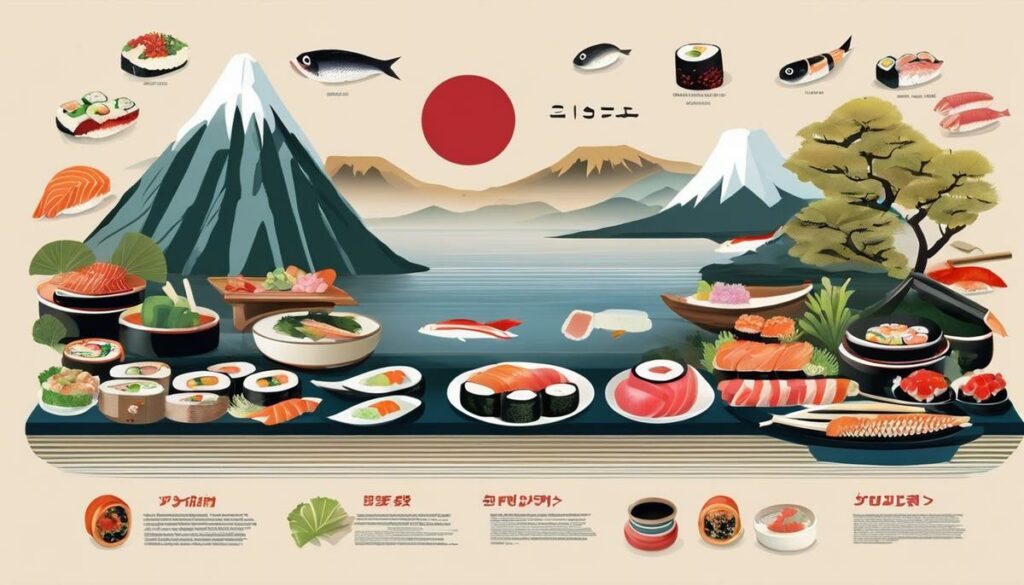The artful food we know and love as sushi has a long and multifaceted history that is deeply rooted in the cultural traditions of Japan and the coasts of Southeast Asia. The beginnings of sushi date back to the time when people first began to preserve fish through fermentation, a technique that was as creative as it was necessary. With the transition to the Yayoi period, the early form of narezushi developed in Japan, laying the foundation for the complex flavor profiles and refined aesthetics that characterize sushi today. During the Edo period, sushi experienced a rapid development that paved its way into modern gastronomy while reflecting the cultural and historical aspects that have influenced this culinary art up to the present day.
The beginnings of sushi
Title: Elegance in the Art of Eating: A Journey Through the Emergence of the Art of Sushi
There are moments in life that captivate with their subtle elegance and refined simplicity. One of these works of art that seduces both the senses and the palate is undoubtedly sushi. Not just a dish, but an attitude to life that combines taste, tradition and an almost poetic expressiveness in each hand-rolled piece.
The origins of the art of sushi are as multifaceted as the patterns of a kimono. It all started more than a thousand years ago in Southeast Asia, where the method of fermenting fish in rice to make it last longer came along. This early form of sushi, known as narezushi, was initially a necessity that eventually turned into a delicacy.
In time, the practice sailed over to Japan, where it underwent a remarkable transformation. In the Edo period (1603-1868), the focus shifted to the freshness of the fish, driven by the thriving fishing industry and the restless sushi makers who set new standards in Edo – today’s Tokyo. Hand-pressed rice, infused with a good drizzle of vinegar and topped with the best the sea had to offer: nigirizushi was born.
Today, sushi is much more than a meal; it’s a cult act, a display of sophistication, and an ode to the ocean’s fresh gifts. Design and precision craftsmanship are crucial to the art of sushi. A good Itamae (sushi master) works with a precision similar to cutting diamonds, presenting his works on porcelain beauties that strike a fine balance between functionality and aesthetic perfection.
Sushi offers endless opportunities for creative expression – whether it’s by playfully arranging nigiri, rolling colorful maki, or composing opulent sashimi platters. Presentation is of paramount importance; each piece is arranged to please the eye as well as the palate, keeping alive the belief that the first taste impression is gained through the eye.
This aesthetic meal has long since achieved global prominence and established itself as an integral part of sophisticated cuisine. Sushi is not only a feast for the eyes, but also a reflection of the personality of everyone who practices this art of eating. Every time you enjoy a piece of sushi, be aware that you’re not just eating food, it’s a history, a tradition, and an art form that’s been honed over centuries.
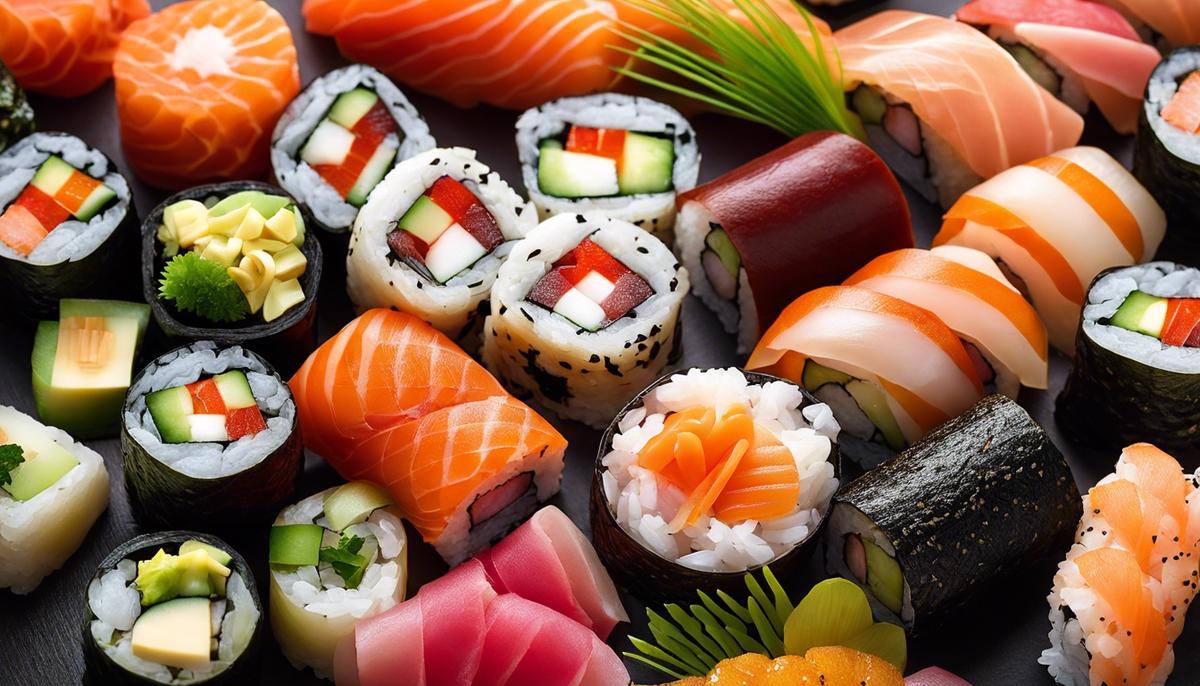
The globalization of sushi
Sushi as a Global Phenomenon
There is no denying it: sushi has conquered the gastronomic globe. But how did this exquisite dish become so widespread and gain a foothold in a wide variety of cultures? It’s not just the traditional techniques and flawless staging that have made sushi a worldwide favorite.
The influence of pop culture and media should not be underestimated. Films, series and documentaries have brought not only the artistry of the preparation, but also the underlying philosophies closer to a wide audience. The insights into the disciplined world of the Itamae – the sushi masters – have aroused respect and admiration for this activity.
Another factor is the internationalization of Japan in recent decades. The rise of the Japanese economy was accompanied by the global spread of its culture – and with it sushi. Major cities around the world are now proud of their authentic sushi restaurants, which uphold and carry on the high art of Japan.
But sushi has also become a symbol of a conscious way of life. In a world where sustainability and conscious nutrition are becoming more and more important, sushi scores with fresh, largely unprocessed ingredients and a balance that flatters both the palate and well-being.
In addition, fusion cuisine has reinvented sushi, adapting it to local tastes. From Californian rolls to tempura-covered creations, sushi has shown a versatility that has only cemented its popularity.
After all, digitalization and the associated interconnectedness of the world have played their part. Social media is a perfect showcase for the visually appealing dish. Images of artfully arranged sushi circulate in feeds and stories, adding to the fascination and whetting the appetite worldwide.
From the intricacies of its preparation to its triumphal march on social media, sushi is more than just food intake. It is a way of life, a piece of culture and a pleasure that transcends borders. In a world that seems to be getting smaller and smaller, sushi has created a universal language of taste that unites people around the great table of gastronomy.
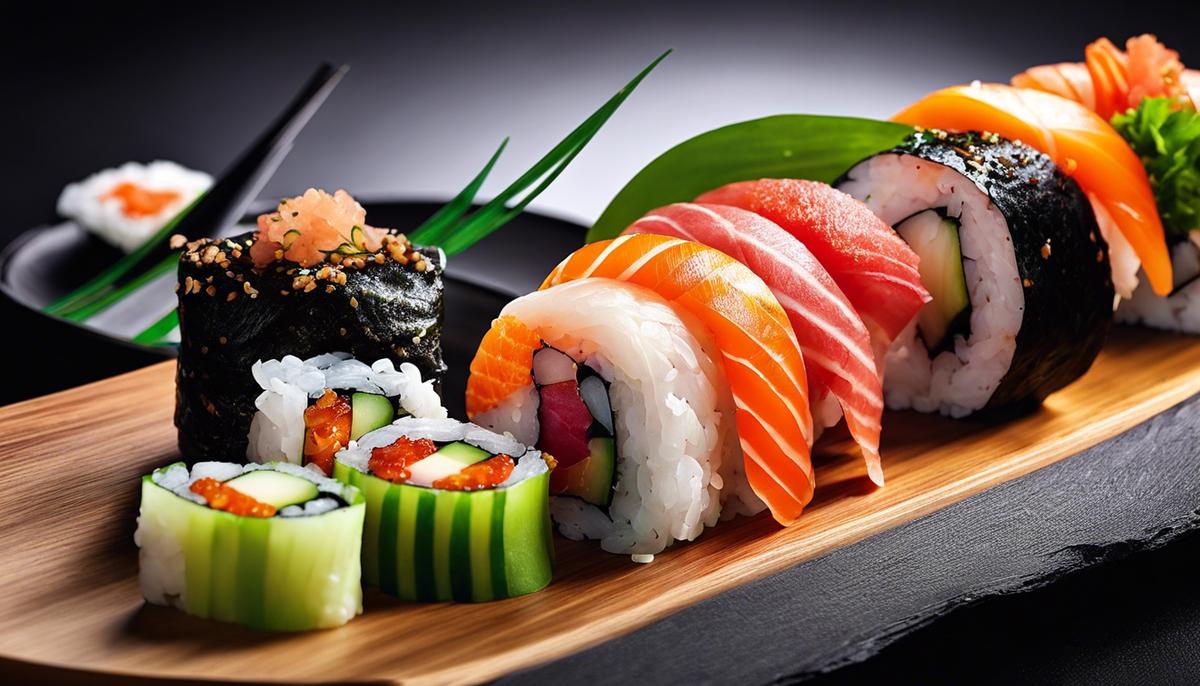
Sushi etiquette and contemporary trends
Today, the world of sushi is full of new trends and rules that are celebrated by connoisseurs and socialites alike. In the fast lane of chic trendy venues and hipster spots, sushi has achieved a status that has gone far beyond traditional boundaries and continues to do so.
Currently, sushi donuts and sushi burritos are a real Instagram must-post. They combine the classic elegance of sushi with a playful touch. These creations are not only a feast for the eyes, but also a taste crossover that promises culinary delights.
Another rule that has become an integral part of modern sushi etiquette is pairings with modern drinks. Sake remains a classic, but now it is joined by special craft cocktails and even wines that are specially matched to the nuances of sushi.
Omakase, the trust in the sushi master, has also become a trendsetter ceremony. Here, the sushi chef personally selects what goes on the plate, leading to an exclusive journey through the menu.
Also noteworthy is the turn to sustainable and ethically correct ingredients. The trend is moving towards conscious enjoyment, where the origin of fish and seafood, which does not include endangered species, is becoming increasingly important.
Then there are almost philosophical aspects: the “less is more” mentality is finding its way into the sushi scene. Minimalism in sushi art means letting each ingredient speak for itself, highlighting the quality of each ingredient.
In the sushi world, dynamism is the measure of all things. The only thing that remains constant is change – and that’s a good thing. So keep your eyes peeled for the next wave of sushi innovation that is sure to excite the taste buds and take over social media. May the future of sushi remain as exciting as its taste and aesthetic heritage.
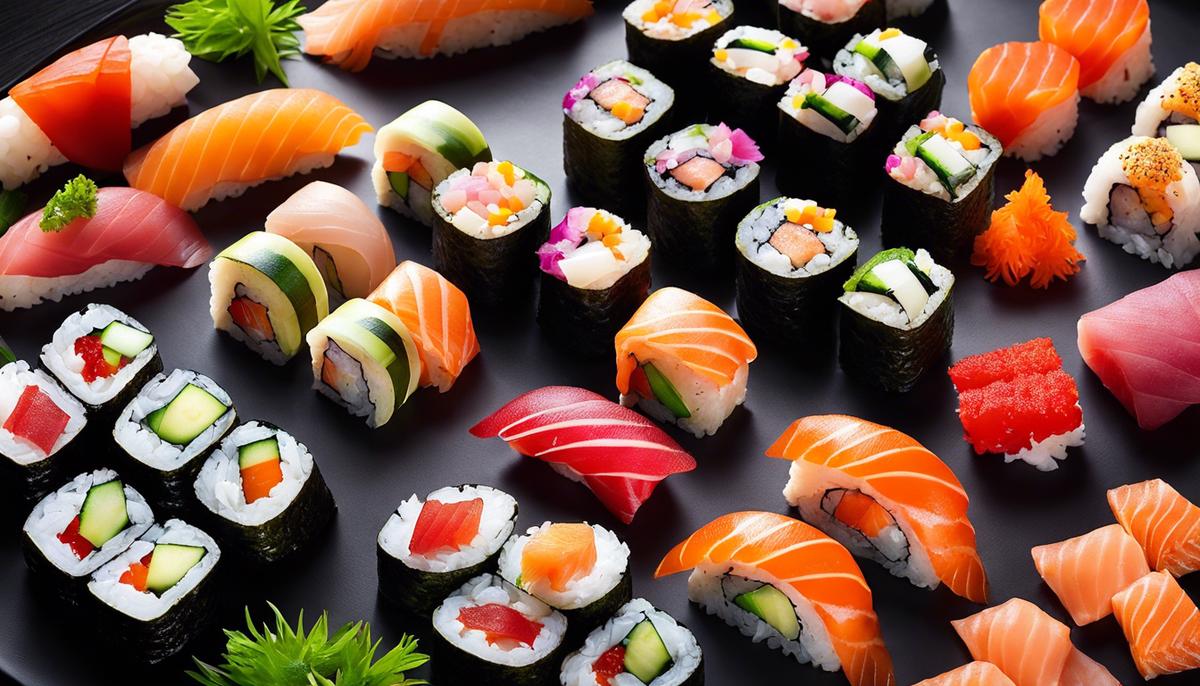
Sustainability and the future of sushi
In a world where sustainability and environmental awareness are steadily gaining in importance, the culinary future of sushi is also in the spotlight. Eco-friendly practices are increasingly being integrated into the preparation and consumption of sushi. Regional and seasonal products play a central role here. It’s all about preserving the oceans while preserving the exquisite flavor of this Japanese delicacy.
Aquaculture, i.e. the breeding of marine animals, is taking on a new lease of life in order to reduce overfishing of the oceans and the associated loss of species. Innovative technologies enable the responsible use of valuable resources and offer environmentally friendly alternatives to wild-caught fish. Thus, farmed fish and alternative seafood that are sustainably harvested or produced form the new basis for innovative sushi creations.
Awareness of vegetarian and vegan sushi is also developing. Classic components such as fish are being replaced by plant-based options. Mushrooms, tofu, marinated vegetables and even fruits become stars of the sushi counter. The combination of traditional techniques and plant-based ingredients results in unique taste sensations that will delight even the most demanding palates.
The use of organic products is becoming more and more common, and this trend is also reflected in the sushi world. The emphasis is on the origin of the ingredients, as well as on the protection of local ecosystems. The transparency of supply chains is becoming increasingly important for sushi lovers who value responsible consumption.
In terms of packaging and presentation, there is also an environmentally friendly change. Reusable tableware and compostable materials are increasingly replacing the widespread single-use plastic packaging. This reinforces the image of sushi as a premium product that is equally committed to aesthetic enjoyment and environmental protection.
Sushi consumption is also increasingly finding its way into digital worlds. Apps that promote the direct purchase of sustainable sushi ingredients and online courses in which the preparation of sushi can be learned sustainably are in demand. Through interactive platforms, knowledge about environmentally friendly sushi is made accessible to a wider public.
In conclusion, the future of sushi in an environmentally conscious world is not only a challenge, but also an opportunity for creativity and innovation. Through the conscious choice of ingredients and techniques, sushi remains a model for a cuisine that combines both enjoyment and sustainability.
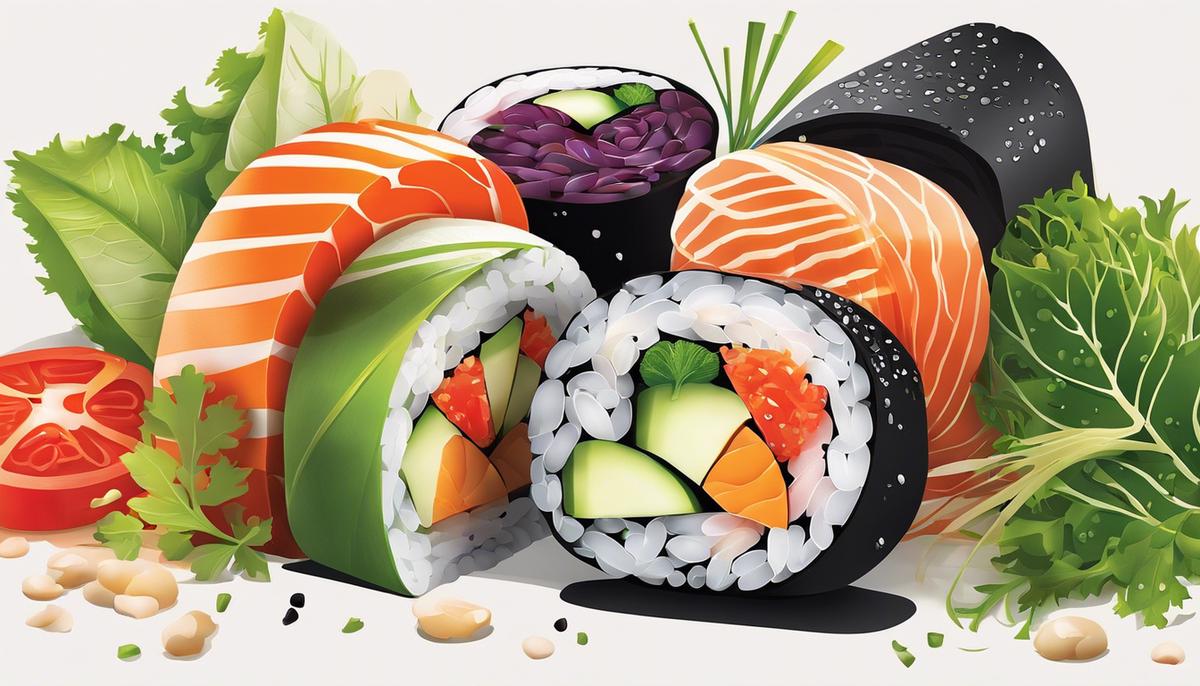
Sushi is more than just a dish; it is a reflective symbol of the harmonious coexistence of tradition and innovation, as well as respect for the environment, which demonstrates globalization, cultural integration and the tireless spirit of human creativity. The responsibility for conserving maritime resources and the future of sushi is now in the hands of chefs, consumers and environmentalists alike. The ability to preserve tradition while still dynamically responding to the changes of time will ensure the survival of this culinary art and guarantee that future generations will be able to enjoy the beauty and taste of sushi in a world increasingly characterized by sustainability and mindfulness.
